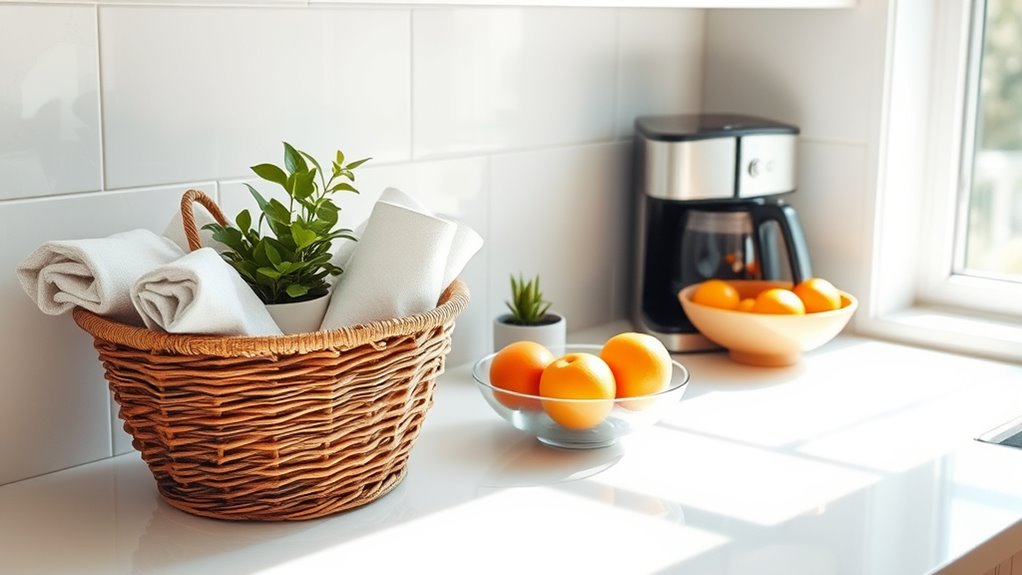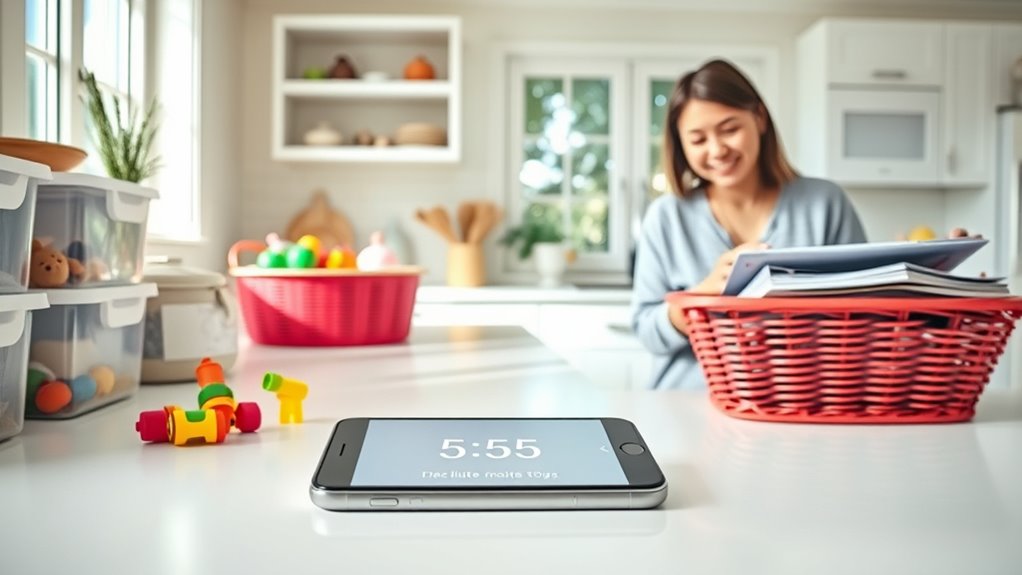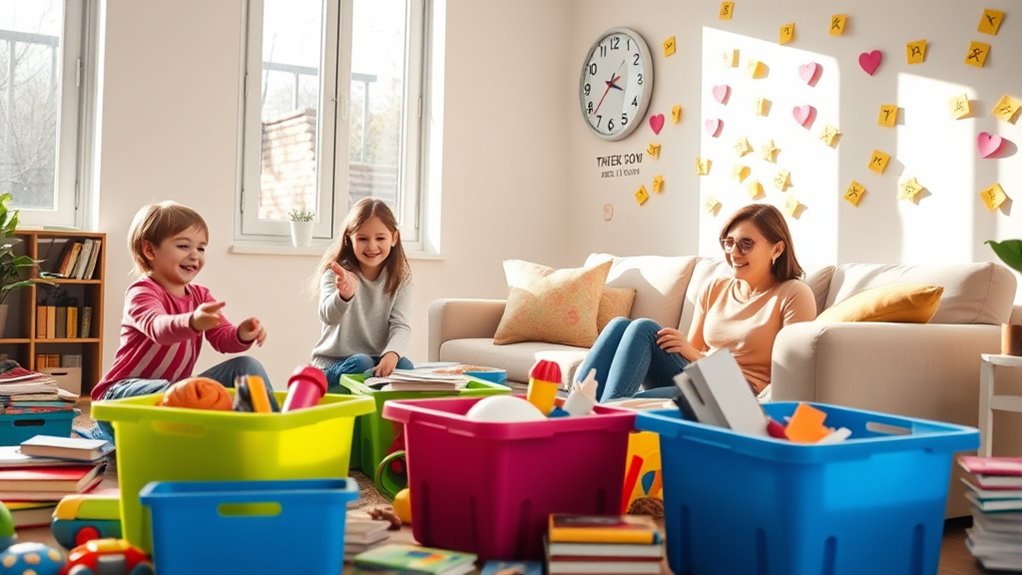In just five minutes, you can tackle clutter and create tidy zones around your home. Focus on high-traffic areas like the kitchen or entryway and set a timer to keep you on track. Start with small areas like a drawer or shelf, and toss expired items for quick wins. Involving your family can make it even easier. Keep these tips in mind, and you'll discover more effective strategies to maintain your organized space effortlessly.
Key Takeaways
- Set a timer for 5 minutes to maintain focus and tackle decluttering without feeling overwhelmed.
- Start with high-traffic areas like kitchens or entryways for immediate visible results.
- Focus on small tasks, such as clearing a shelf or organizing a drawer.
- Utilize vertical storage solutions to maximize space and keep items organized.
- Celebrate small wins to boost motivation and encourage consistent decluttering habits.
Time Efficiency: Making the Most of 5 Minutes

When you're juggling a busy schedule, it's easy to feel overwhelmed by clutter, but you can make a significant impact in just 5 minutes.
Start by setting a timer to keep your focus sharp and prevent the task from feeling daunting. Target high-traffic areas like your kitchen or entryway, where small changes can yield big results. Start small and simple by focusing on just one small area, such as a single shelf or drawer, to avoid feeling overwhelmed. Implementing vertical storage solutions can also help maximize the space you have available.
Focus on easy decisions—toss expired items or quick-sort through shoes. Clearing visible surfaces can instantly improve your space's appearance.
Building a Daily Decluttering Habit

Short bursts of decluttering can be highly effective, but building a daily habit takes it a step further. Start small by focusing on one area at a time; this helps you avoid feeling overwhelmed.
Use timers for 5 or 15-minute sessions to keep your focus sharp. Incorporate decluttering into your daily routine—doing it during breakfast or right after waking up works well.
Target high-impact areas first to see immediate results. Involve your family by assigning tasks and making it a fun activity.
Commit to a few minutes each day, celebrating small wins to stay motivated. Remember, consistency is key, so be flexible yet dedicated to maintaining this habit for a clutter-free home. Additionally, consider creating a designing the perfect alfresco living space to enjoy a tidy outdoor area as a reward for your efforts.
Practical Applications: Quick Decluttering Tasks

Quick decluttering tasks can make a significant difference in maintaining a tidy home, especially for busy moms. Start by sorting through socks, tossing out worn-out pairs. Next, tackle your junk drawer—remove trash and rearrange items for easy access. Streamline your collection of water bottles by donating or recycling the extras. Don't forget to simplify entryways; straighten up and wipe down shelves. Clear your pantry by checking for expired items and removing those you no longer use. Consistent efforts can lead to lasting results, so set a timer for five to ten minutes daily to focus on one area at a time, and involve your family to make it a fun activity. Additionally, consider how financial considerations can impact your ability to maintain a clutter-free environment, as effective management of resources can support ongoing organization efforts. These quick tasks keep clutter at bay and your home feeling organized.
Benefits of Regular Decluttering for Moms

Regularly decluttering offers numerous benefits that can significantly improve your life as a busy mom.
First, it reduces chaos in your home, leading to a calmer environment and improved mental wellbeing. With less clutter, you'll find enhanced focus, making it easier to tackle daily tasks. Additionally, a less cluttered home promotes a more peaceful atmosphere, which can positively impact your family's overall mood.
Decluttering creates a serene home, boosting mental wellbeing and enhancing focus for a more productive daily routine.
Decluttering also helps manage feelings of overwhelm, simplifying your space and routines. Financially, it can save you money by reducing unnecessary purchases and minimizing waste.
Plus, with fewer items to clean, you'll have more time for family and personal activities.
Strategies to Tackle Clutter as a Busy Mom

As you juggle the many responsibilities of motherhood, tackling clutter can feel overwhelming, but implementing effective strategies can make a significant difference. Start small by focusing on one area at a time, and set a timer for short decluttering sessions to keep you on track. Involve your family by assigning tasks to lighten your workload. Create a plan by breaking tasks into manageable steps with realistic goals. Maximize hidden storage spaces to keep clutter out of sight. Use baskets and bins to corral similar items, and label containers so everyone knows where things belong. Remember the Four-Box Method: keep, donate, trash, and relocate items. Additionally, understanding filial responsibility laws can help you plan financially for your family's needs while you manage your space. These strategies can help you reclaim your space without adding extra stress to your day, and creating designated homes for your items will further reduce clutter build-up.
Maintaining a Clutter-Free Home With Consistency

To maintain a clutter-free home, it's essential to develop consistent daily habits that keep mess at bay.
Start by washing and putting away dishes right after meals to keep your kitchen tidy. Smart tips suggest returning clothes to their designated spots to prevent laundry piles from forming.
Make it a point to tidy up the living room daily and clear bathroom counters of toiletries. Don't let mail pile up; process it immediately to avoid paper clutter. Small daily habits are key to maintaining a clutter-free home.
Implementing these small habits consistently helps create a more organized environment.
Utilizing Technology for Effective Decluttering

Maintaining a clutter-free home extends beyond physical spaces; it also includes managing your digital environment. Utilize digital decluttering apps like CCleaner or CleanMyMac to automate cleanup and keep your devices running smoothly. Store important files on cloud platforms like Google Drive or Dropbox, which makes accessing documents easy and reduces time wasted searching. Credit Score management tools like LastPass simplify account management by securely storing your login details. Regularly use clean email tools to declutter your inbox and enhance focus. Establish a logical folder organization and routinely delete unnecessary files to maintain a tidy digital workspace. Digital decluttering is essential for enhancing attention span and reducing stress, allowing you to focus on what truly matters. Automating mundane tasks will free up time for what matters most—keeping your home and mind clutter-free.
Turning Decluttering Into a Family Activity

While decluttering might seem like a daunting task, turning it into a family activity can make it both manageable and enjoyable.
Start by implementing a daily decluttering routine, like the 5-Minute Declutter Method, and encourage everyone to join in. Set realistic goals to avoid feeling overwhelmed, and consider making it a fun challenge or game. Incorporate donation drop-offs into your regular weekend routines to prevent accumulation of unwanted items.
Assign age-appropriate tasks so everyone contributes, and don't forget to celebrate successes with rewards or praise. Scheduling regular family decluttering sessions and nightly tidy-ups can create a sense of unity, much like pet therapy does in enhancing emotional well-being.
Lead by example, communicate the benefits, and involve everyone in decision-making. This way, decluttering becomes a shared responsibility rather than a chore, making your home organized and harmonious.
Frequently Asked Questions
What Items Should I Prioritize When Decluttering?
When you're decluttering, prioritize high-traffic areas like your living room, kitchen, and entryway to create a welcoming space.
Focus on essential items—keep only the clothing you wear regularly, necessary kitchenware, and organized books.
Use storage solutions like bins and shelves to maintain order.
Make it a habit to incorporate daily decluttering, involve your family, and regularly donate items you no longer need.
This keeps your home organized and clutter-free.
How Can I Involve Children in Decluttering Efforts?
"Many hands make light work."
To involve your children in decluttering, start with small tasks that keep them engaged. Create a fun atmosphere and use sorting categories to make decisions easier.
Lead by example, showing them how to declutter effectively. Offer incentives to motivate participation, and consider turning it into a game.
This way, they'll learn responsibility, teamwork, and decision-making skills, all while keeping your space organized together.
What if I Can't Decide What to Keep or Discard?
If you can't decide what to keep or discard, start by acknowledging your feelings about each item.
Imagine the worst-case scenario if you let it go; this can help clarify what truly matters.
Focus on easy decisions first to build momentum, and set short time limits for each session.
Establish clear rules, like the "One-Year Rule," to simplify choices.
Celebrate your progress, no matter how small, to stay motivated and encouraged.
How Do I Stay Motivated During Decluttering Sessions?
Staying motivated during decluttering can feel like asking a cat to take a bath—good luck with that!
But seriously, start small and set a timer for just 10 minutes. Visualize your clutter-free sanctuary and celebrate those tiny victories.
Make a plan and focus on one area at a time. Remember, it's a marathon, not a sprint. Reflect on how great it'll feel, and before you know it, you'll be on a roll!
What Tools Can Assist With Organizing After Decluttering?
To effectively organize after decluttering, you'll want to gather some essential tools.
Pop-up bins can hold donations, while garbage and recycling bags keep everything tidy. A label maker helps you categorize items, and using a tape measure ensures everything fits perfectly.
Don't forget multifunctional furniture and shelving units for additional storage.
With these tools, you can create an organized space that stays clutter-free and functional for your daily needs.
Conclusion
In just five minutes a day, you can transform your home from chaos to calm. Think of decluttering as a daily reset button, allowing you to reclaim your space and peace of mind. By embracing these quick strategies, you not only make your environment more manageable but also set an example for your family. So, why not start today? Remember, a clutter-free home isn't just a dream—it's a choice you can make, one five-minute session at a time.









